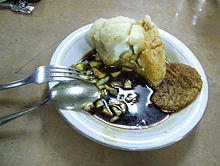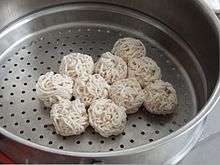Pempek: Difference between revisions
| Line 25: | Line 25: | ||
[[File:Making pempek.JPG|thumb|right|Pempek dough is the base of various shaped pempeks.]] |
[[File:Making pempek.JPG|thumb|right|Pempek dough is the base of various shaped pempeks.]] |
||
It is made of dough, simple,right? |
|||
===Dough=== |
|||
Pempek [[dough]] is made from a mixture of boneless ground fish meat, most commonly ''tenggiri'' ([[wahoo]]), with water, salt and [[sago]] flour. People sometimes add a little bit of cooking oil and/or wheat flour to improve texture and not to make the pempek too chewy and to add [[Monosodium glutamate|MSG]] to enrich the [[umami]] taste. ''Ikan gabus'' ([[Channa striata|snakehead]]) is also commonly made as pempek. Numerous pempek sellers and producers in Palembang use a cheap combination of fish, which has a strong scent. According to tradition, the best tasting pempek are made of ''belida'' or ''belido'' (''[[Chitala lopis]]''), but due to its rarity and superior taste, pempek made from this fish are usually more expensive.<ref>[http://pempekcekma.com/pempek/sejarah-pempek/ Cek Ma: Sejarah Pempek Palembang]</ref> Pempek in [[Bangka Island]] are made from [[mackerel]] (''ikan kembung'') and its sauce is red chilli based, while in Jakarta or other cities they could be made from ''[[gourami]]'' fish. The latest variant is ''pempek udang'', pempek made of minced [[shrimp]] originated from Sungsang area in [[Banyuasin]] near the Musi river estuary,<ref>[http://bisniskeuangan.kompas.com/read/2010/08/08/21255829/Aprilina..Mengatrol.Gengsi.Pempek.Udang Kompas.com: Aprilina, Mengatrol Gengsi Pempek Udang]</ref> it is noticeable with its pinkish color. |
|||
The dough is boiled in hot water or steamed until hardened as partly cooked dumplings, and stored to be fried later just before serving. |
|||
===Sauce=== |
===Sauce=== |
||
Revision as of 05:34, 23 August 2017
 Varieties of pempek. | |
| Course | Main course or snack |
|---|---|
| Place of origin | Indonesia |
| Region or state | Palembang, South Sumatra |
| Serving temperature | Hot |
| Main ingredients | Fish cake from mixture dough of fish and tapioca, egg, noodle, palm sugar, vinegar and tamarind, dried shrimp powder |
| Variations | Lenggang, Tekwan, Model, or Rujak Mie. |
Pempek, mpek-mpek or empek-empek is a savoury fishcake delicacy from Palembang,[1]South Sumatera, Indonesia, made of fish and tapioca. Pempek is served with rich sweet and sour sauce called kuah cuka or kuah cuko (lit. vinegar sauce), or just "cuko". Sometimes local people also add yellow noodles for variations.
Origin
Pempek is the best-known of Palembang's dishes.[2] Its origin is undoubtedly Palembang. However, the history behind the creation of this savoury dish is unclear. According to local tradition, around the 16th century there was an old Chinese immigrant who lived near the Musi river. He noticed an abundance of fish caught by the local fishermen. In the Sumatran tropical climate, before the invention of refrigeration technology, most of these unsold leftover fish decayed and were wasted. The indigenous people, however had limited knowledge and techniques for processing fish. During that period, most of the indigenous people simply grilled, fried or boiled their fish instead of adding other ingredients to make new dishes. The old Chinese man mixed in some tapioca and other spices, which he then sold around the village on his cart. The people referred to this old man as 'pek-apek, where apek is a Chinese slang word to call an old man. The food is known today as empek-empek or pempek.
Another theory suggests that pempek was a Palembang adaptation of Southern Chinese ngo hiang or kekkian (fish slice) as a surimi (魚漿, yújiāng) based food. But instead of being served in soup or plainly fried, pempek is notable for its spicy palm sugar-vinegar based sauce.
Ingredients

It is made of dough, simple,right?
Sauce
Kuah cuko is produced by adding palm sugar, chili pepper, garlic, vinegar, and salt to boiling water. The color of this sauce is dark brown. Sometimes Tongcai and Ebi (ground dried shrimp) are also added to increase the flavor. This sweet, sour and spicy sauce is essential for flavouring the pempek, since the pempek dough is very mildly savoury. The sauce of Bangka pempek is chili based, made from the mixture of ground red chili and vinegar and its color is bright red. Traditionally all pempek sauces are served hot and spicy, the ground chilies are mixed in the sauce. However, since some people desire unspicy sauce, or cannot eat hot and spicy sauce, the ground chillis were often separated as sambals. In some pempek restaurants, the bottled kuah cuko sauce is left on customers' tables and they are welcome to pour on the amount of sauce they desire. There are two kind of sauces available, spicy hot and plain.
Serving
The boiled or steamed pempek dumplings are deep-fried in cooking oil until light pale brown right before serving. They are cut in bite-size, served with yellow noodles or rice vermicelli, showered in kuah cuko, and sprinkled with chopped cucumber and ebi powder. The additional fish krupuk crackers might be offered.
Variants

This fishcake dough can be made into various shapes and forms with additional ingredients. Just like pasta the shapes have their own distinctive names, although all are made from the same dough. There are many varieties of pempek,[3] pempek variants are:
- Pempek kapal selam: (Indonesian: submarine pempek), which is made from a chicken egg wrapped within the pempek dough and then deep-fried. The shape is similar to Chinese dumplings but larger in size. According to food science and technology scientist, the pempek kapal selam, with egg addition, is rich in protein, fat, vitamin a, mineral, and carbohydrate content, is the most nutritious variety.[4] The name derived from the shape of pempek that resembles submersible midget submarine.

- Pempek telur kecil: (Indonesian: small egg pempek), filled with egg similar to pempek kapal selam, but smaller in size.
- Pempek lenjer: long cylindrical pempek, its shape is similar to sausages.

- Pempek keriting: (Indonesian: curly pempek), the dough is made into small noodle ball. This similar process also applied to produce white krupuk.
- Pempek pistel: the shape and size is similar to pempek telur kecil, but filled with minced young papaya instead.
- Pempek kulit: (Indonesian: skin pempek), fish-skin pempek, the dough is mixed with minced fish skin, as the result it has stronger fishy aroma and darker color.
- Pempek adaan: ball shaped pempek.
- Pempek tahu: tofu sliced and filled with pempek dough.
- Pempek Tunu: charcoal-grilled pempek. It is stuffed with ebi, sweet kecap sauce and chilli sauce.
- Pempek model (Model Iwak): tofu wrapped inside pempek dough. Similar to pempek kapal selam, but egg is replaced with tofu. Instead of served with cuko, it is served in shrimp soup.
Most of those pempek in various forms are deep fried in cooking oil until light pale brown, and served with yellow noodles or rice vermicelli and kuah cuko, sprinkled with chopped cucumber and ebi powder.
The pempek fishcake can be used as a base ingredient of other dishes. The unfried cylindrical pempek lenjer is often cut and added as a mixture to the following dishes:
- Celimpungan: small pempek balls cooked in spicy coconut milk, served with chilli and sprinkled with bawang goreng (fried shallots).
- Laksan: often referred to as Palembang style pempek in laksa soup, sliced pempek fishcake served in coconut milk based soup.
- Lenggang: omelette with mixture of sliced pempek fishcake, also served in kuah cuko.
- Tekwan: chopped pempek fishcake soup with jicama, mushroom and fishballs.
